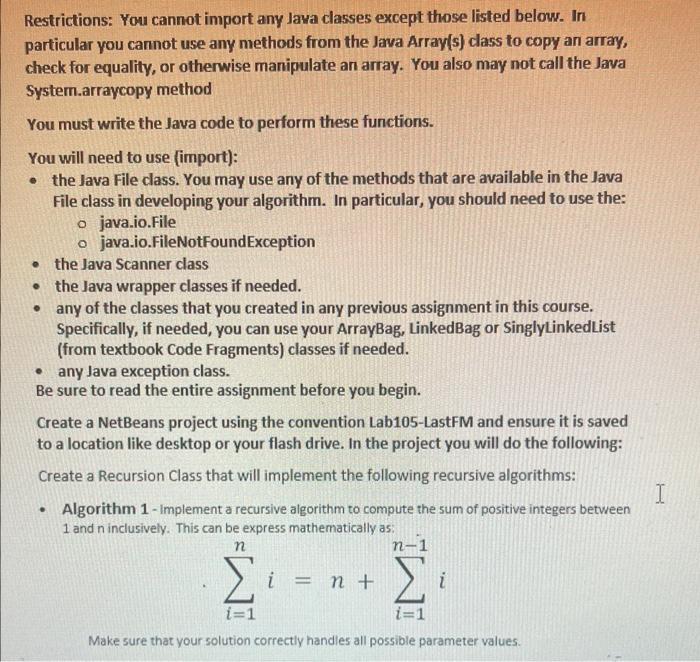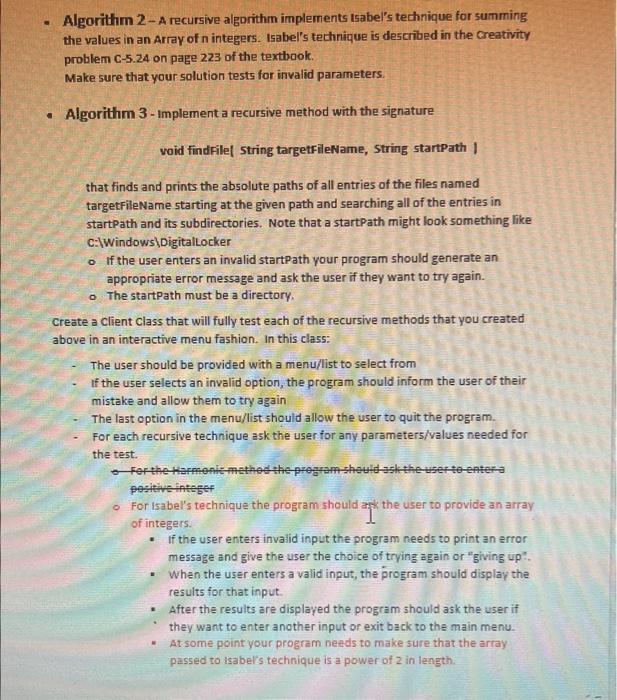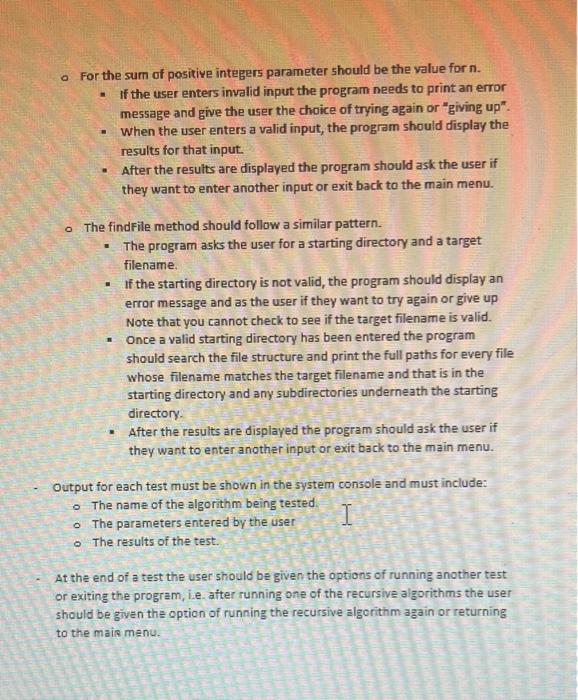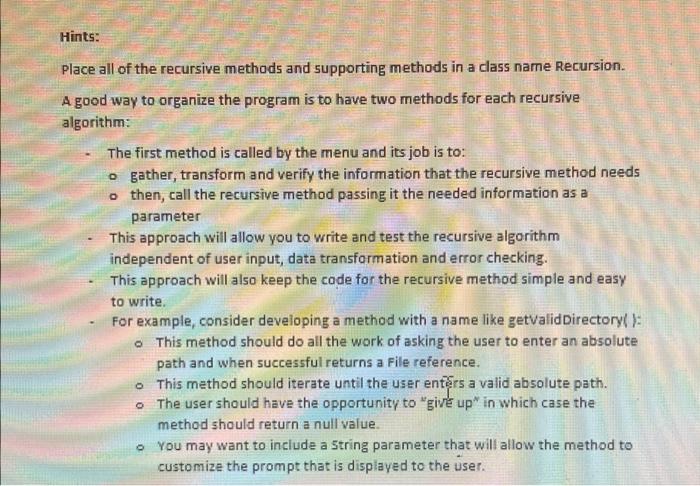Lab105 Lab105 Assignment Page 1 of Due Date: Friday,02/24@11:59pm Tuesday 02/28@11:59pm Points: 100 This is an individual assignment. Restrictions: You cannot import any Java classes except those listed below. In particular you cannot use any methods from the Java Array(s) class to copy an array, check for equality, or otherwise manipulate an array. You also may not call the Java System.arraycopy method You must write the Java code to perform these functions. You will need to use (import): - the Java File class. You may use any of the methods that are available in the Java File class in developing your algorithm. In particular, you should need to use the: java.io.File java.io.FileNotFoundException - the Java Scanner class - the Java wrapper classes if needed. - any of the classes that you created in any previous assignment in this course. Specifically, if needed, you can use your ArrayBag, LinkedBag or SinglyLinkedList (from textbook Code Fragments) classes if needed. - any Java exception class. Be sure to read the entire assignment before you begin. Create a NetBeans project using the convention Lab105-LastFM and ensure it is saved to a location like desktop or your flash drive. In the project you will da the following: particular you cannot use any methods from the Java Array(s) class to copy an array, check for equality, or otherwise manipulate an array. You also may not call the Java System.arraycopy method You must write the Java code to perform these functions. You will need to use (import): - the Java File class. You may use any of the methods that are available in the Java File class in developing your algorithm. In particular, you should need to use the: - java.io.File - java.io.FileNotFoundException - the Java Scanner class - the Java wrapper classes if needed. - any of the classes that you created in any previous assignment in this course. Specifically, if needed, you can use your ArrayBag, LinkedBag or SinglylinkedList (from textbook Code Fragments) classes if needed. - any Java exception class. Be sure to read the entire assignment before you begin. Create a NetBeans project using the convention Lab105-LastFM and ensure it is saved to a location like desktop or your flash drive. In the project you will do the following: Create a Recursion Class that will implement the following recursive algorithms: - Algorithm 1 -Implement a recursive algorithm to compute the sum of positive integers between 1 and n inclusively. This can be express mathematically as: i=1ni=n+i=1n1i Make sure that your solution correctly handles all possible parameter values. - Algorithm 2-A recursive algorithm implements Isabel's technique for summing the values in an Array of n integers. Isabel's technique is described in the Creativity problem C5.24 on page 223 of the textbaok. Make sure that your solution tests for invalid parameters. - Algorithrn 3 - implement a recursive method with the signature void findFile( string targetFileName, string startPath | that finds and prints the absolute paths of all entries of the files named targetfileName starting at the given path and searching all of the entries in startpath and its subdirectories. Note that a startPath might look something like C:-WindowsDigitalLocker - If the user enters an invalid startpath your program should generate an appropriate error message and ask the user if they want to try again. - The startpath must be a directory. Create a client class that will fully test each of the recursive methods that you created above in an interactive menu fashion. In this cla55: - The user should be provided with a menu/list to select from - If the user selects an invalid option, the program should inform the user of their mistake and allow them to try again - The last option in the menu/list should allow the user to quit the program. - For each recursive technique ask the user for any parameters/values needed for the test. For Isabel's technique the program should agk the user to provide an array of integers. - If the user enters invalid input the program needs to print an error message and give the user the choice of trying again or "giving up". - When the user enters a valid input, the program should display the results for that input. - After the results are displayed the program should ask the user if - they want to enter another input or exit back to the main menu. - At some point your program needs to make sure that the array passed to isabel's technique is a power of 2 in length. - For the sum of positive integers parameter should be the value for n. - If the user enters invalid input the program needs to print an error message and give the user the choice of trying again or "giving up". - When the user enters a valid input, the program should display the results for that input. - After the results are displayed the program should ask the user if they want to enter another input or exit back to the main menu. - The findfile method should follow a similar pattern. - The program asks the user for a starting directory and a target filename. - If the starting directory is not valid, the program should display an error message and as the user if they want to try again or give up Note that you cannot check to see if the target filename is valid. - Once a valid starting directory has been entered the program should search the file structure and print the full paths for every file whose filename matches the target filename and that is in the starting directory and any subdirectories underneath the starting directory. - After the results are displayed the program should ask the user if they want to enter another input or exit back to the main menu. Output for each test must be shown in the system console and must include: The name of the algorithm being tested. - The parameters entered by the user - The results of the test. At the end of a test the user should be given the options of running another test or exiting the program, i.e. after running one of the recursive algorithms the user should be given the option of running the recursive algorithm again or returning to the mais menu. Place all of the recursive methods and supporting methods in a class name Recursion. A good way to organize the program is to have two methods for each recursive algorithm: - The first method is called by the menu and its job is to: o gather, transform and verify the information that the recursive method needs o then, call the recursive method passing it the needed information as a parameter - This approach will allow you to write and test the recursive algorithm independent of user input, data transformation and error checking. - This approach will also keep the code for the recursive method simple and easy to write. - For example, consider developing a method with a name like getvalidDirectory( ): - This method should do all the work of asking the user to enter an absolute path and when successful returns a File reference. - This method should iterate until the user entrs a valid absolute path. - The user should have the opportunity to "give up" in which case the method should return a null value. - You may want to include a string parameter that will allow the method to customize the prompt that is displayed to the user. Lab105 Lab105 Assignment Page 1 of Due Date: Friday,02/24@11:59pm Tuesday 02/28@11:59pm Points: 100 This is an individual assignment. Restrictions: You cannot import any Java classes except those listed below. In particular you cannot use any methods from the Java Array(s) class to copy an array, check for equality, or otherwise manipulate an array. You also may not call the Java System.arraycopy method You must write the Java code to perform these functions. You will need to use (import): - the Java File class. You may use any of the methods that are available in the Java File class in developing your algorithm. In particular, you should need to use the: java.io.File java.io.FileNotFoundException - the Java Scanner class - the Java wrapper classes if needed. - any of the classes that you created in any previous assignment in this course. Specifically, if needed, you can use your ArrayBag, LinkedBag or SinglyLinkedList (from textbook Code Fragments) classes if needed. - any Java exception class. Be sure to read the entire assignment before you begin. Create a NetBeans project using the convention Lab105-LastFM and ensure it is saved to a location like desktop or your flash drive. In the project you will da the following: particular you cannot use any methods from the Java Array(s) class to copy an array, check for equality, or otherwise manipulate an array. You also may not call the Java System.arraycopy method You must write the Java code to perform these functions. You will need to use (import): - the Java File class. You may use any of the methods that are available in the Java File class in developing your algorithm. In particular, you should need to use the: - java.io.File - java.io.FileNotFoundException - the Java Scanner class - the Java wrapper classes if needed. - any of the classes that you created in any previous assignment in this course. Specifically, if needed, you can use your ArrayBag, LinkedBag or SinglylinkedList (from textbook Code Fragments) classes if needed. - any Java exception class. Be sure to read the entire assignment before you begin. Create a NetBeans project using the convention Lab105-LastFM and ensure it is saved to a location like desktop or your flash drive. In the project you will do the following: Create a Recursion Class that will implement the following recursive algorithms: - Algorithm 1 -Implement a recursive algorithm to compute the sum of positive integers between 1 and n inclusively. This can be express mathematically as: i=1ni=n+i=1n1i Make sure that your solution correctly handles all possible parameter values. - Algorithm 2-A recursive algorithm implements Isabel's technique for summing the values in an Array of n integers. Isabel's technique is described in the Creativity problem C5.24 on page 223 of the textbaok. Make sure that your solution tests for invalid parameters. - Algorithrn 3 - implement a recursive method with the signature void findFile( string targetFileName, string startPath | that finds and prints the absolute paths of all entries of the files named targetfileName starting at the given path and searching all of the entries in startpath and its subdirectories. Note that a startPath might look something like C:-WindowsDigitalLocker - If the user enters an invalid startpath your program should generate an appropriate error message and ask the user if they want to try again. - The startpath must be a directory. Create a client class that will fully test each of the recursive methods that you created above in an interactive menu fashion. In this cla55: - The user should be provided with a menu/list to select from - If the user selects an invalid option, the program should inform the user of their mistake and allow them to try again - The last option in the menu/list should allow the user to quit the program. - For each recursive technique ask the user for any parameters/values needed for the test. For Isabel's technique the program should agk the user to provide an array of integers. - If the user enters invalid input the program needs to print an error message and give the user the choice of trying again or "giving up". - When the user enters a valid input, the program should display the results for that input. - After the results are displayed the program should ask the user if - they want to enter another input or exit back to the main menu. - At some point your program needs to make sure that the array passed to isabel's technique is a power of 2 in length. - For the sum of positive integers parameter should be the value for n. - If the user enters invalid input the program needs to print an error message and give the user the choice of trying again or "giving up". - When the user enters a valid input, the program should display the results for that input. - After the results are displayed the program should ask the user if they want to enter another input or exit back to the main menu. - The findfile method should follow a similar pattern. - The program asks the user for a starting directory and a target filename. - If the starting directory is not valid, the program should display an error message and as the user if they want to try again or give up Note that you cannot check to see if the target filename is valid. - Once a valid starting directory has been entered the program should search the file structure and print the full paths for every file whose filename matches the target filename and that is in the starting directory and any subdirectories underneath the starting directory. - After the results are displayed the program should ask the user if they want to enter another input or exit back to the main menu. Output for each test must be shown in the system console and must include: The name of the algorithm being tested. - The parameters entered by the user - The results of the test. At the end of a test the user should be given the options of running another test or exiting the program, i.e. after running one of the recursive algorithms the user should be given the option of running the recursive algorithm again or returning to the mais menu. Place all of the recursive methods and supporting methods in a class name Recursion. A good way to organize the program is to have two methods for each recursive algorithm: - The first method is called by the menu and its job is to: o gather, transform and verify the information that the recursive method needs o then, call the recursive method passing it the needed information as a parameter - This approach will allow you to write and test the recursive algorithm independent of user input, data transformation and error checking. - This approach will also keep the code for the recursive method simple and easy to write. - For example, consider developing a method with a name like getvalidDirectory( ): - This method should do all the work of asking the user to enter an absolute path and when successful returns a File reference. - This method should iterate until the user entrs a valid absolute path. - The user should have the opportunity to "give up" in which case the method should return a null value. - You may want to include a string parameter that will allow the method to customize the prompt that is displayed to the user











